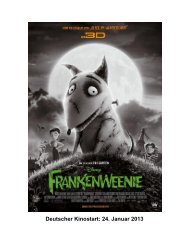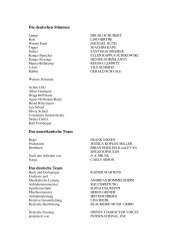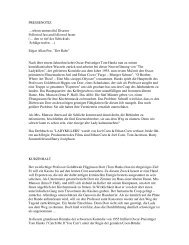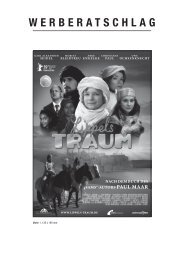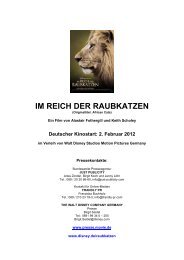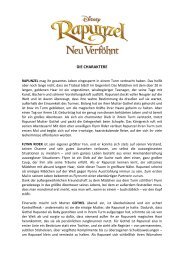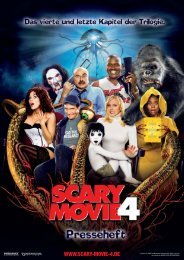crank - Walt Disney Studios Motion Pictures Germany
crank - Walt Disney Studios Motion Pictures Germany
crank - Walt Disney Studios Motion Pictures Germany
Create successful ePaper yourself
Turn your PDF publications into a flip-book with our unique Google optimized e-Paper software.
the script for this frenetic film, and it fit perfectly. Their look is frenzied and incredibly<br />
dynamic. There’s a lot of movement but it goes beyond that. And it goes into the actual<br />
quality of the video that they’re shooting.”<br />
Theodroakis adds, “Neveldine and Taylor are big video fanatics, which is sort of<br />
refreshing because most of the time when I shoot High Definition with people, they’re<br />
shooting HD maybe because they can’t afford film, or they view it as something that<br />
should just look like film. However, here are two young guys that actually grew up on<br />
video and look at it as an art form in itself, which is great because we could develop a<br />
look that is not quite film and not quite traditional video or HD. It’s something that is just<br />
quintessential Crank, a ‘Neveldine-Taylor Look.’ ”<br />
Shooting the film digitally, however, meant that the filmmakers were forced to deal with<br />
some inevitable disadvantages, or as producer Wright recalls, “We were on twelve<br />
different learning curves at once on this production, which made for a somewhat<br />
frightening experience at times.” The Sony 950s, the cameras preferred on set, had a<br />
cable attaching the camera to a deck, which meant that it wasn’t initially mobile enough<br />
to travel with camera operator Neveldine during shots, especially the more fast-paced<br />
action sequences. The solution to the problem came in creating what’s been termed the<br />
‘nanocam,’ a backpack that enabled Neveldine to hold a disassembled piece of the<br />
camera, the lens and an image plate in his hand, while the rest of the camera, deck and<br />
battery belt stayed firmly strapped to him from behind.<br />
Richard Wright says, “The main advantage is that you actually have, in effect, your<br />
laboratory on the set. Our digital image technician Nick Theodorakis is able to adjust the<br />
aperture – the brightness, color, crispness – fifteen different axes of adjustment to the<br />
image on the fly. So you can start indoors in one light level, walk outdoors into<br />
completely different light and adjust it as you go. It makes lighting much faster and<br />
makes shots that otherwise would have been impossible or at least very difficult, very<br />
possible. It also gives us the ability to see instantly that we’ve gotten a shot.”<br />
Theodorakis notes that using HD, in addition to efficiency, also adds a more intense<br />
look—one that Crank is using to groundbreaking effect. “Usually, in traditional<br />
filmmaking, you use the shutter to enhance an action scene,” he explains, “And it really<br />
has only been used for that [action scenes] up until this point. In Saving Private Ryan,<br />
they’re on the beach, everything is melee and there’s gunfire all around, the shutter is<br />
amped up. Otherwise they revert back to your standard hundred and eighty degree shutter<br />
look, which is what we’re all used to—smooth and very normal.”<br />
“On this one, the idea was sort of fitting in the name of Crank,” he continues. “We <strong>crank</strong><br />
it up right away—our baseline shutter angle is what most people use for a standard action<br />
sequence, which was another argument we had in the very beginning—you know, can we<br />
do this? Can we start with an incredibly high energy feeling and keep that throughout the<br />
movie? We tested it and loved the results we got. Even on dialogue scenes, we still closed<br />
down the shutter angle so you get a bit more of a frenetic feeling. And that’s so cool








